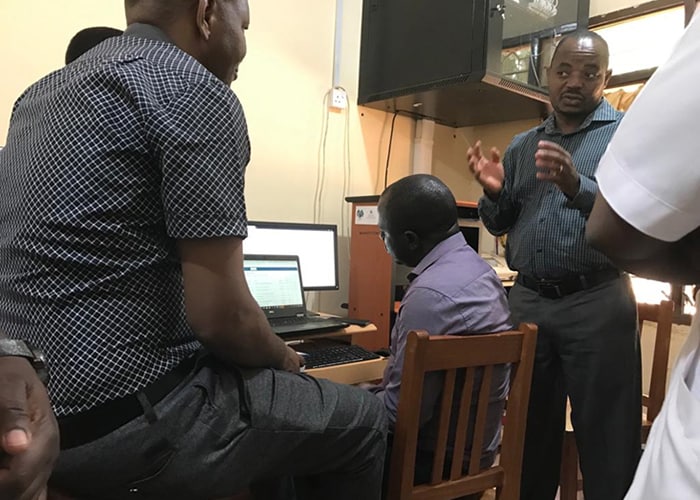Rapid Results Initiative Leaves Lasting Impact

Dr. Kazitanga conducting a site assessment
Introduction and Gaps in Tanzania’s HIV epidemic control
In February 2019, five U.S. Centers for Disease Control and Prevention (CDC) Tanzania employees received a temporary change of address. The Tanzania HIV Impact Survey (THIS) results, first published in December 2017, led to the re-organization of programming efforts to reach HIV epidemic control. The survey results estimated that Kagera and Mwanza regions had the largest number of persons living with HIV (PLHIV) who were not yet diagnosed and, therefore, are not receiving anti-retroviral treatment (ART). Instead of simply supporting local partners and health officials from Dar-es-Salaam, a team of five traveled to the regions to provide hands-on technical assistance for three months. This intensive effort was called the Rapid Response Initiative (RRI).
Innovative Hands-On Approach
CDC, through the U.S. President’s Emergency Plan for AIDS Relief, supports comprehensive HIV services in 11 of the 26 regions in mainland Tanzania, plus Zanzibar. In May 2018, in an effort to support partners to accelerate progress towards control of the HIV epidemic, CDC staff members were grouped into Regional Teams providing ongoing management and support in an effort to better understand and address challenges at a site and regional level. Employees focus on priority issues and provide remote and in-person assistance when necessary. Through the RRI, smaller teams spent three consecutive months providing intensive on-site support to address the critical HIV gaps in Kagera and Mwanza.
The Kagera RRI Team consisted of the late Dr. David Bwogi and Dr. Jaiving Kazitanga. They worked closely with the local clinical partner, Management for Developments for Health (MDH), and government officials to address gaps, provide onsite technical assistance, and review data to track progress. Explaining the success of RRI, Dr. Kazitanga pointed to its unique problem-solving approach.
“We went to supported health facilities with their performance data and sat with staff and partners to discuss areas where they were underperforming,” Kazitanga said. “We proposed some solutions and worked together as team to fix problems on the spot. For instance, if there was no privacy to screen clients for HIV, we immediately changed the screening location to ensure there was privacy and confidentiality for clients. It was a simple but effective change.”
Talumba Samatta, MDH’s Regional Project Manager in Kagera, agrees the hands-on approach was well-needed and well-received. “The pressure (in Kagera) to improve HIV outcomes was high.” Samatta said. “It was good to get additional support from CDC and bring in new ideas and initiatives. We were happy to know they were coming not just to supervise, but to help us find practical solutions to problems.”
Yielding Results
Overall, in the Kagera region, there were great improvements in finding previously undiagnosed PLHIV and linking them to treatment. Different strategies were employed, including index testing—which focuses on testing sexual partners, needle sharing contacts, and biological children of PLHIV. In Quarter 1 of FY19 (October 1, 2018- December 31, 2018), the Kagera region identified 1,324 HIV positive individuals through index testing. By the end of FY19 (July 1, 2019- September 30, 2019), 6,147 HIV positive individuals were identified through index testing.
RRI also emphasized techniques to link those identified as HIV positive to lifesaving ART. Thanks in part to RRI, Kagera demonstrated a more than 35 percent increase in the number of people on ART in the region – from more than 54,883 as of September 30, 2018 to 74,921 by September 30, 2019. These increased efforts to identify PLHIV and link them to ART is essential for Tanzania to reach HIV epidemic control.
Progress through the Mwanza RRI was slow to start, for a variety of reasons. “The HIV testing Focal Person learned how the health care workers (HCW) at the facilities were aggressive in eliciting clients, and how systematic MDH was in measuring the impact of their interventions,” said CDC Tanzania’s Dr. Edward Machage. “This led Ariel Glaser Pediatric AIDS Healthcare Initiative to implement a daily achievement tracker, similar to a system implemented in Kagera, and focus their efforts on longer-term, intensive site visits.” Soon Mwanza was seeing the impact of their interventions as well. The number of people on ART in Mwanza increased from 66, 372 in September 30, 2018 to 84,557 September 30, 2019.
RRI framework integrated as routine Regional Team Activities
By April 2019, the RRI teams packed their bags and returned to Dar-es-Salaam, but they were not saying “kwaheri” (goodbye) as ongoing support was provided through regional team activities. The RRI Kagera team now confidently supports Kagera from afar knowing they left behind a new set of practices and strengthened regional relationships for improvements to continue. For example, MDH and members of the regional government meet weekly to analyze and clean the data for the highest burden sites, and to discuss recent and upcoming events. The Kagera regional government is committed to improving HIV outcomes in the region. “They want to know everything happening in their district and (the regional government) attend the events to understand all they can,” Samatta said. Besides investing in relationships and capacity building, the RRI approach is continually utilized. “When we do site visits now, we ask the same questions as we did during RRI,” Samatta said.
Beyond Kagera and Mwanza, the other regions have also leveraged best practices learned from RRI and have implemented small-scale RRI’s in other regions where a little support is needed to accelerate progress. Longer-term site visits have been undertaken in Shinyanga, Mara and Tabora regions, with a focused approach on specific indicators and sites to maximize performance.






















.png)











No hay comentarios:
Publicar un comentario